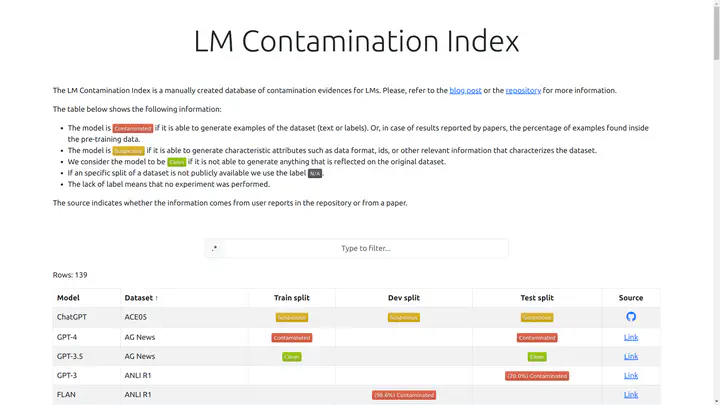
Benchmark Integrity at Risk: The Growing Challenge of Data Contamination in Large Language Models
The Hidden Flaw: When AI Models “Cheat” on Their Exams
The rapid evolution of large language models (LLMs) has been nothing short of spectacular. Each new release, from GPT-3.5 to the more advanced GPT-4, demonstrates remarkable leaps in capability, consistently achieving state-of-the-art results on a wide array of academic and industry benchmarks. This progress, chronicled in the latest GPT Models News, fuels excitement across the entire tech landscape, from GPT Applications News to specialized fields like GPT in Healthcare News. However, a critical and often overlooked issue threatens to undermine the very foundation of how we measure this progress: data contamination.
Data contamination occurs when the datasets used to evaluate a model’s performance are inadvertently included in its training data. In essence, the model has seen the “answer key” before taking the test. This doesn’t imply malicious intent but is rather a byproduct of the massive, web-scale data collection methods used to train modern AI. Recent findings and ongoing analysis within the AI research community suggest that even the most sophisticated models may be “contaminated” with popular benchmark datasets. This article delves into the nuances of this challenge, exploring how it happens, why it matters, and what the AI community can do to ensure the integrity of our evaluation methods and foster genuine, generalizable intelligence.
Understanding Data Contamination: A Foundational Challenge
At its core, data contamination compromises the fundamental principle of machine learning evaluation: testing a model on unseen data. The goal is to measure a model’s ability to generalize patterns and knowledge to new, novel situations. When test data leaks into the training set, we are no longer measuring generalization; we are, at least in part, measuring memorization. This is a critical distinction that impacts everything from GPT Research News to practical GPT Deployment News.
What is Data Contamination?
Imagine a student preparing for a final exam. The ideal preparation involves studying the course material to understand the underlying concepts. Data contamination is akin to that student getting a copy of the exact exam questions and memorizing the answers. While they might score 100%, it reveals nothing about their actual comprehension. In the context of LLMs, we can identify two primary forms of contamination:
- Direct Contamination: This is the most straightforward form, where examples from a benchmark dataset (e.g., AG News for topic classification, XSum for summarization) are directly present in the training corpus. This often happens when web scrapers ingest online repositories, forums, or educational websites where these datasets are hosted or discussed.
- Indirect or Conceptual Contamination: This form is more subtle. It occurs when paraphrased versions, detailed analyses, or discussions about the benchmark examples are included in the training data. The model might not see the exact test sample, but it learns strong associations and patterns related to it, which can still inflate performance.
How Does It Happen? The Scale and Scraping Problem
The root cause of data contamination lies in the sheer scale of the data required to train models like GPT-4. These models are fed terabytes, even petabytes, of text and code from vast internet crawls like Common Crawl. The philosophy is to expose the model to the broadest possible spectrum of human knowledge. However, this indiscriminate scraping is a double-edged sword.
Academic benchmark datasets, once confined to university servers, are now widely accessible. They are hosted on GitHub, discussed on Stack Overflow, analyzed in blog posts, and cited in papers on arXiv. All of this content is prime fodder for web crawlers. The intricate and costly process of cleaning and de-duplicating these massive datasets, a key topic in GPT Training Techniques News, cannot guarantee the removal of every instance of every benchmark. Identifying and purging these needles from a multi-trillion-token haystack is one of the most significant challenges in modern AI development, impacting everything from GPT-3.5 News to the future architecture of GPT-5 News.

The Detective Work: Methods for Identifying Contamination
Uncovering data contamination is a complex forensic task that requires sophisticated techniques. Researchers cannot simply ask a model if it has “seen” a piece of data. Instead, they must employ clever methods to find evidence of memorization and exposure, which is a key focus of current GPT Benchmark News.
Sequence Matching and N-gram Overlap
The most common initial approach is to search for direct overlaps. This involves taking sentences or passages from a benchmark dataset and searching for identical or near-identical sequences within the known training corpus. This is often done using n-grams (contiguous sequences of ‘n’ items from a sample of text). For example, a researcher might search for specific 13-gram overlaps between a test set and the training data.
Real-World Scenario: A research team evaluating a model on the WNLI (Winograd NLI) benchmark, which tests pronoun resolution, might take a specific sentence from the test set, such as “The city councilmen refused the demonstrators a permit because they feared violence.” They would then run a search across the model’s training data to see if this exact sentence appears. Finding it would be a clear case of direct contamination.
Advanced and Inference-Based Detection
Direct matching has its limits, as it can miss paraphrased content. More advanced techniques are emerging to combat this:
- Generation Probing: This involves prompting the model with the beginning of a benchmark example and observing its completion. If the model completes the example verbatim, especially if it’s a long or unique passage, it’s a strong sign of memorization. This is particularly relevant for generative tasks like summarization or translation.
- Membership Inference Attacks: These are more sophisticated methods where an attacker tries to determine if a specific piece of data was part of the training set by analyzing the model’s output, confidence scores, or behavior. High confidence (low perplexity) on a specific example compared to similar examples can indicate prior exposure. This has significant implications for GPT Privacy News and GPT Safety News.
The Challenge of Quantifying Impact
Simply detecting contamination is only half the battle. The harder question is quantifying its impact on benchmark scores. Does a 1% contamination rate lead to a 1% score inflation, or does it have a disproportionate effect? The answer is complex and depends on the benchmark’s nature and the model’s architecture. This uncertainty complicates the comparison between different models and clouds the narrative of GPT Competitors News, making it difficult to ascertain which performance gains are genuine breakthroughs in reasoning versus artifacts of data leakage.
Why It Matters: The Far-Reaching Consequences of Tainted Data
Data contamination isn’t just an academic curiosity; it has profound, cascading effects on the entire AI ecosystem, from research integrity to the safe deployment of real-world applications. The latest OpenAI GPT News and discussions around GPT Regulation News are increasingly focused on the reliability and verifiability of model capabilities.

Eroding Trust in Benchmarks
Benchmarks are the yardstick by which we measure progress in AI. They are designed to be objective, standardized tests of a model’s abilities in areas like language understanding, reasoning, and code generation. Contamination invalidates this purpose. When scores are inflated, we can no longer trust them as a reliable measure of a model’s generalization power. This makes it incredibly difficult to compare models fairly, track true scientific progress, or understand the limitations of systems discussed in GPT Code Models News and GPT Multimodal News.
Misleading Progress and Inflated Capabilities
If the AI community relies on contaminated benchmarks, we risk developing a skewed perception of AI capabilities. We might believe models are more capable at complex reasoning or nuanced understanding than they actually are. This can lead to:
- Misallocated Resources: Research and funding may be directed away from fundamental problems under the false assumption that they have already been “solved.” – Premature Deployment: Organizations might deploy models in high-stakes environments like GPT in Finance News or GPT in Legal Tech News, believing the model has a proven level of reliability that it doesn’t actually possess when faced with truly novel data.
- Hype Cycles: Inflated performance can fuel unrealistic expectations, leading to disillusionment when models fail to perform as advertised in real-world scenarios, a recurring theme in GPT Trends News.
Impact on the Broader GPT Ecosystem
The issue extends beyond foundational models. The entire ecosystem of GPT Plugins News, GPT Custom Models News, and GPT Fine-Tuning News relies on the integrity of the base models. If a base model like GPT-4 is contaminated, that contamination is inherited by every fine-tuned version and application built upon it. A developer using the GPT APIs News to build a specialized chatbot for customer service might be unknowingly benefiting from a model that has memorized answers to common industry evaluation questions, giving a false sense of its out-of-the-box competence.
Charting a Clearer Course: Solutions and Recommendations

Addressing the data contamination challenge requires a multi-faceted approach involving model developers, researchers, and practitioners. It is a shared responsibility to uphold the scientific rigor of AI evaluation. This involves not just better algorithms, but a cultural shift towards transparency and critical analysis.
For Data Curators and Model Developers
- Aggressive Decontamination and Cleaning: Investment in more sophisticated data-cleaning pipelines is crucial. This includes developing better algorithms for fuzzy matching and semantic duplicate detection to catch not just exact copies but also paraphrased versions of benchmark data. This is a significant challenge related to GPT Hardware News, as these processes are computationally expensive.
- Data Transparency: Following the “datasheets for datasets” model is a step in the right direction. Model creators should be more transparent about their training data sources, cleaning procedures, and the specific steps taken to mitigate contamination. This transparency is a cornerstone of the GPT Open Source News movement.
- Novel and Dynamic Benchmark Design: The community must develop new evaluation methods. This could include creating private benchmarks that are held back from the public internet until after a model is trained or designing dynamic benchmarks where test cases are generated algorithmically, making prior contamination impossible.
For Researchers and Practitioners
- Perform Critical Evaluation: Do not take benchmark leaderboards at face value. When selecting a model, look for independent analyses and contamination studies. Always test models on your own private, in-domain datasets to get a true measure of their performance for your specific application.
- Focus on Qualitative Analysis: Go beyond accuracy scores. Analyze a model’s failures and successes. Does it demonstrate genuine reasoning, or is it providing answers that feel regurgitated? This qualitative insight is often more valuable than a single metric.
- Advocate for Better Practices: As users of the GPT Ecosystem News and various GPT Platforms News, practitioners should demand greater transparency from model providers. Supporting organizations that prioritize ethical and rigorous evaluation helps move the entire field forward.
Conclusion: Towards a More Reliable Future
Data contamination is not a minor flaw but a systemic challenge born from the very methods that have made LLMs so powerful. The quest for ever-larger datasets has inadvertently compromised the tools we use to measure our progress. The recent revelations about major models containing benchmark data serve as a critical wake-up call for the entire AI community. Moving forward, we must shift our focus from solely chasing higher scores to ensuring the validity of those scores.
By investing in advanced data hygiene, fostering a culture of transparency, and developing more robust, contamination-resistant evaluation paradigms, we can build a more trustworthy and reliable foundation for the future of AI. Addressing this conundrum is essential not just for academic integrity, but for safely and effectively harnessing the transformative potential of technologies like GPT in every facet of our world, from GPT in Education News to GPT in Content Creation News.



